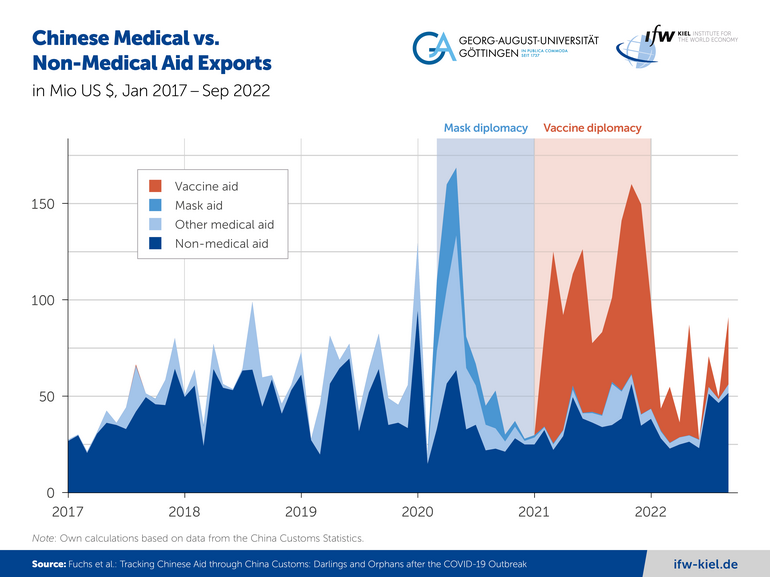News
China's global aid exports: Development assistance according to geopolitical interest

”In recent years, China has grown to become one of the world's largest donors of development aid,” says Andreas Fuchs, Director of the Kiel Institute China Initiative and Professor of Development Economics at Göttingen University. ”However, the full amount of aid has not been made public, which made it difficult for other donor countries to use their development aid strategically and effectively. Our database now makes China's aid deliveries more transparent.”
The Chinese Aid Exports Database contains all Chinese aid shipments by official and private donors since 2017 and is based on official Chinese export statistics. The database covers 195 countries. 184 of those received goods sent as aid from China. Only goods deliveries are recorded, not money transfers. The methodology and procedure for analyzing the data are explained in a Kiel Working Paper: Tracking Chinese Aid through China Customs: Darlings and Orphans after the COVID-19 Outbreak.
Recognition of Taiwan disqualifies countries from receiving aid from China
The latest data update is from September 2022, according to which China has again stepped up its aid deliveries after the start of the Russian war against Ukraine in the form of grain to Africa after a long pause. In September alone, China delivered grain worth USD 1.15 million. The recipient countries were Gambia, Eritrea, Ethiopia, Djibouti, and Somalia.
An evaluation of the years 2017 to 2021 shows that China exported a total of USD 4.2 billion worth of aid, or an average of USD 835 million per year. The better a country is politically aligned with China, the more aid flows it receives. For example, recognition of Taiwan as a sovereign state almost completely disqualifies a country from receiving Chinese aid.
With the outbreak of the COVID-19 pandemic, the export of medical supplies such as face masks, vaccines, or respirators increased dramatically. Relief supplies from other areas declined. In the period from March 2020 to December 2020, medical face masks accounted for almost a quarter of all aid shipments from China; in 2021, vaccines dominated aid shipments with a share of almost 60 per cent.

”The outbreak of the COVID-19 pandemic marks a turning point in China's delivery of aid. In the course of its ‘mask diplomacy’ in 2020, China also supplied high-income countries, and even political rivals, at the expense of countries who had been recipients of aid in the past, especially in Africa. China has obviously seized the opportunity to expand its political sphere of influence,” says Fuchs.
Mask diplomacy: Germany recipient of Chinese aid items
Germany, for example, received medical face masks worth almost USD 5 million and the USA almost USD 17 million. One of the biggest beneficiaries of China's ‘mask diplomacy’—in terms of population size—was Luxembourg, with mask deliveries worth almost USD 13 million. The country is considered an administrative center for China's ‘New Silk Road’ and therefore strategically important.
China’s economic competitors, Russia and India, were also supplied with masks by China, worth just under USD 20 million and at least USD 5 million respectively. With the ’vaccine diplomacy’ of 2021, however, Beijing went back to its previous principles: aid recipients of the vaccine were mainly politically aligned and economically poor countries.
Overall, between January 2017 and September 2022, the recipients of the most generous aid packages in terms of export value were Cambodia (USD 261 million), Ethiopia (USD 198 million), Pakistan (USD 193 million), Tajikistan (USD 181 million), and Myanmar (USD 163 million). Taken together, medical supplies dominate the period, while non-medical aid such as food, electronic equipment, and building materials follow a way behind.
Find out more about the database: Chinese Aid Exports Database
